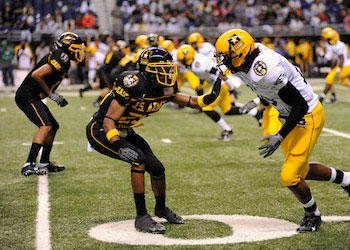Chances are you’ve seen athletes wearing detached sleeves on their arms or legs—or long sleeves under their uniforms in the middle of summer.  Most of the sleeves are compression sleeves (or leggings) made of a nylon/spandex blend fabric that fit tightly around the arms or legs. They come in a variety of shapes and sizes—as sleeves, socks, shorts, and even full-body suits. So what are compression sleeves, and what do they do?
Most of the sleeves are compression sleeves (or leggings) made of a nylon/spandex blend fabric that fit tightly around the arms or legs. They come in a variety of shapes and sizes—as sleeves, socks, shorts, and even full-body suits. So what are compression sleeves, and what do they do?
Compression garments help push blood toward your heart and prevent blood from “pooling” or collecting in the compressed areas. The amount of pressure, or compression, they provide depends on the type and size of the garment. Some sleeves have padding in them, others are just a sleeve without padding. They range in the amount of compression they provide. The padding has an obvious use: to protect elbows and knees from falls on a hard surface. The unpadded ones are worn to improve performance and recovery, to help keep muscles warm, for comfort, or just because they look cool.
The exact way compression sleeves work is still a bit of a mystery, but researchers believe the compression helps limit swelling and improve blood flow to remove waste, such as lactic acid, created by the normal muscle damage that takes place during exercise.
“Performance enhancement” depends on how you define performance
If you’re interested in improving your performance while participating in an activity, the evidence is mixed as to whether compression sleeves work. The best way to find out if a compression sleeve (or two) ups your game is to try it for yourself. If you feel it helps you perform better, then that’s all you need.
Wearing compression sleeves during or after participating in an activity can help reduce muscle soreness and strength recovery.
If you want to improve your recovery after activity, the answer is clearer. Wearing compression sleeves during or after participating in an activity has been shown to help reduce the severity of delayed onset muscle soreness (DOMS) and improve strength recovery for some people. The effects aren’t huge, but after a hard workout when you would normally expect to be sore, you might not be as sore. Also, the recovery-enhancing effects are more noticeable a day or two after your workout than in the first few hours after it. The benefits of wearing compression sleeves/leggings are also a bit better for resistance training and cycling than for running.
Bottom line
Compression sleeves might offer you some benefit in recovering from your workouts. As long as they aren’t so tight they cut off your circulation, there’s no harm in wearing them. So if you feel better wearing a compression garment during or after exercise, then keep doing what works!




